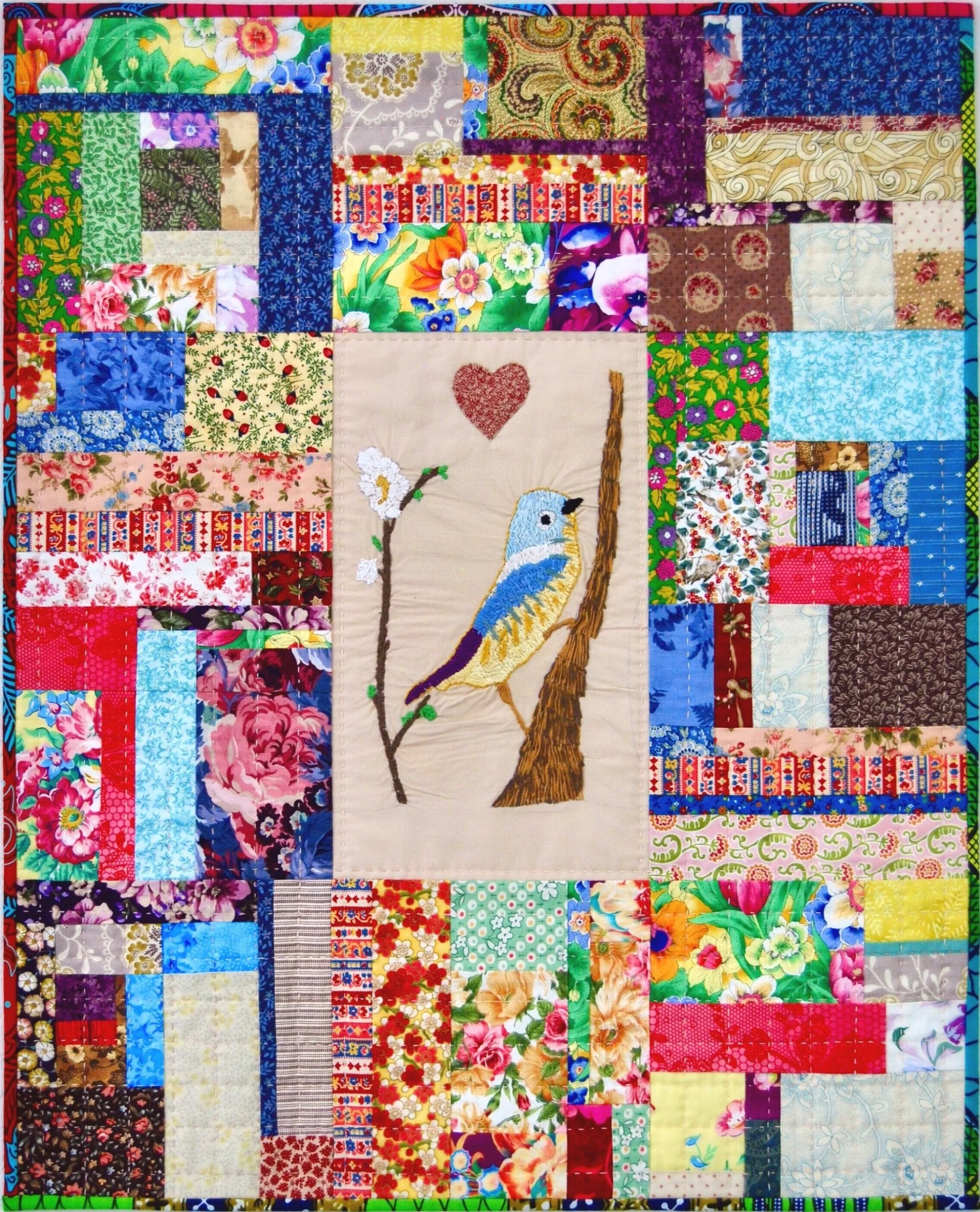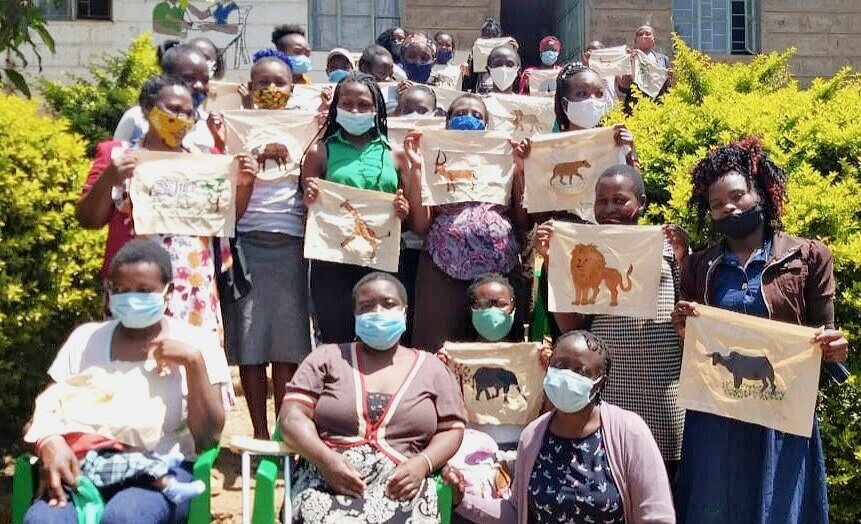Hope Flits and Floats, 2025, 26.5”h x 22”w; machine-pieced and quilted, hand-appliqued; embroidered bird and butterflies by Ugandan artist Nancy Layet, found fabric, thread, batting
Sister Artists 3 — Uganda
The Advocacy Project announced the third Sister Artists project last fall to benefit the women survivors of sex trafficking in Uganda. Earlier this year I received embroidered blocks made by my sister artist, Nancy Layet, and completed this quilt shown on right.
In all, 37 quilts completed by volunteer artists will be on view May 30-31 at the George Washington University Museum and The Textile Museum in Washington, D.C. These quilts will be auctioned online starting May 28th through June 7, 2025. The previous two Sister Artists projects in Mali and Kenya had successfully raised over $12,000 for African women survivors.
I’d like to share Nancy Layet’s story which was included with the embroidered blocks sent to me:
Nancy is 40 years old. She was abducted in 1991 at the age of 13 while in primary four (third grade). She returned in 2004.
“I watched my father and a few other people be beaten to death the day I was abducted. 10 other girls and I were abducted in the same area; 5 of us returned home and the other 6 never made it back. I was told that my mother died of a heart attack from watching her children be taken away and witnessing the death of her husband. My parents left behind 5 children and when I returned home, I struggled to provide for them. My siblings and I missed parental love. I tried to offer them love, but it is still very hard.
I later thought of having a man to settle with. We had 3 children; 1 passed on, and 2 are alive. His family and our neighbors stigmatized him for having children with a rebel. The man later rejected me and my 2 children. I returned home to be with my siblings and my children. Life is so hard. I miss my parents because I know that they would be guiding me and maybe supporting me through this tough situation, but I have no one to turn to. I struggle to pay rent; as a result all of my siblings and children have fallen out of school. I rent land to do farming to get food to feed ourselves.
I was a young girl who had not yet started seeing her period when the man took me to become his wife and forcefully raped me. I was hurt, and this took some time to heal. I also sustained a bullet in my knee, and was told that it is too hard to remove it. The knee pains me a lot, especially during the rainy season when it is cold. I cannot walk for a long distance before it starts causing me pain.”
You can read more about Sister Artists 1 Mali and Sister Artists 2 Kenya below.
Sunflowers: Devotion to Seeking the Light of Truth, 2022, 16” x 16”; machine pieced and quilted; found/recycled fabric, thread, batting
A Fundraiser for Ukraine
In May, I made this quilt for the Sunflower Mini-Quilt Challenge: A Fundraiser for Ukraine by the International Quilt Museum in Lincoln, Nebraska. Quilters were invited to create a 16-inch square quilt inspired by a Sunflower quilt in the museum’s permanent collection.
In designing this quilt, I imagined bright sunflowers against the blue sky to reflect the colors of the Ukrainian flag. The angular squares on-point of the Sunflower quilt by unknown maker (made in mid-1800’s) at the International Quilt Museum inspired the geometric layout and abstracted imagery of my quilt. The sunflower symbolizes many qualities across many cultures around the world: devotion, honesty, longevity, prosperity, endurance, peace, and happiness. I wish for all this and victory, too, for the people of Ukraine.
In all, 219 donated quilts were auctioned June 8-10, 2022 to raise money for the Rotary Disaster Response Fund directly supporting Ukraine’s disaster relief. The online auction raised over $27,000 for Ukraine.
Colors of Kenya
The lovely bird embroidered by Kenyan sister artist, Carol Achieng, inspired me to be colorful and joyful in this project. I also discovered from online research that this lilac-breasted roller, often considered one of the most beautiful birds in the world, is Kenya’s (unofficial) national bird. Aided by their long tail streamers, lilac-breasted rollers are known for their acrobatic aerial displays during courtship, which is where they get their name. Many Kenyans believe the wide array of feather colors – green, white, tan, black, yellow, turquoise, royal blue, reddish-brown, and lilac – symbolize the many different tribes of Kenya.
To reflect this rich diversity and the importance of wildlife conservation in Kenya, I used only found fabric and saved scraps in many rainbow colors. On the center panel I appliqued a red heart as a message of hope and love from sisters in USA to sisters in Kenya.
Sister Artists 2 — Kenya
I was involved with the first Sister Artists project in Mali, Africa (see my entry below) and the success of that fundraiser has led to Sister Artists 2 in Kenya; and I’m happy to participate again.
The Kenyan embroidered panels were created during the pandemic’s heightened social and economic hardship providing emotional and financial support to women in under-served urban communities. Thereafter, the North American sister artists completed the art quilts in June, 2021; there are 39 quilts in this collection. I’ve titled my collaborative quilt Colors of Kenya.
On March 8, 2022, the online auction of Sister Artists 2 quilts opened — this date celebrates International Women’s Day. And then on March 11-12, the quilts were exhibited in-person at The Textile Museum at George Washington University in Washington, D.C. The exhibition catalog is available for purchase at The Advocacy Project.
Please support this effort, go to The Advocacy Project for more information.
Colors of Kenya, 2021, 28”h x 23”w; machine-pieced, hand-quilted, hand-appliqued; Kenyan embroidered panel, found fabric, African wax print, cotton, thread, batting
Sister Artists in the informal settlement of Kibera, a neighborhood in Nairobi. Photo by The Advocacy Project
Sister Artists in the informal settlement of Kangemi, a neighborhood in Nairobi. Photo by The Advocacy Project
For My Sisters
I rarely buy fabric. I find plenty on the free tables at various guild meetings I attend. And in the materials I come across I sense real life stories — lots of scraps, of course, plenty of yardages as well, partially completed projects, new materials and tattered ones, too. Recycling is an important component of my art practice and I love knowing what I take off the donation tables don’t end up in our landfills. As a result, For My Sisters art quilt is wonderfully scrappy. All fabrics were found including a red linen curtain used for binding and backing. The outer border of African batiks was repurposed from an unfinished project of mine.
Of the found fabrics were a few cut squares of U.S. patriotic prints with blue and white stars. I added a red heart (yes, cut from a found fabric) as a message of hope and love from folks in USA to the survivors in Mali.
Sister Artists 1 — Mali
During the 2019 summer, I kept busy with a volunteer project called Sister Artists to raise money for women of sexual violence in Mali, Africa. American artists were invited to select an embroidered panel made by one of these survivors and create an art quilt for auction. [You can spot my sister artist in the image below, standing, second from right.]
On January 25, 2020, the Sister Artists quilt collection premiered at The Textile Museum at George Washington University in Washington, DC for a one-day popup exhibit. However, plans for the followup exhibit in New England were cancelled due to COVID-19 precautions. An exhibition catalog of all the art quilts has been produced and can be found at The Advocacy Project website.
Finally in June, 2020, after much delay and adjustments, all 41 art quilts were auctioned online. To learn more about the Sister Artists program, visit The Advocacy Project and its partner organization, Quilt for Change.
For My Sisters, 2019, 42.5"h x 44"w; machine pieced, hand quilted, hand appliqued; Malian embroidered panel, found fabric, sashiko thread, machine thread, beads, batting
Photo by The Advocacy Project
Finding Fiber
During the transitional period between woodworking and fiber arts, I tinkered with various recycled materials. Here are some of those I kept.
2017 — 58"h x 10"w x 12"d
Candy Striped Chandelier
This was an exercise in creative recycling during winter, just after Christmas. From trial and error with various unwanted materials, a pleasing design emerged.
Plastic holiday garlands were unstrung. Paper straws and yarn re-connected them. Wooden wreath forms gave structure. A single brass shelf bracket kicking around the house finally found its purpose.
It hangs in a space where my kids’ many jubilant school artworks are displayed.
2016 — 72"h x 30"w x 21"d
Homage to Crepe Myrtle
A common sight in the South is the abundance of Crepe Myrtles. Here in Texas these lovely trees leaf-out in spring, explode in color in summer and come every winter, are severely reduced in stature. It's a sorrowful sight and it's a reminder that folks can be taken to action without much thought to merits or consequences. This branch was found on my street curb.
Crepe Myrtles originated from Southeast Asia and are prized for its beauty, medicinal properties and quality timber. In India Crepe Myrtle has been used to cure diabetes for a long time. Flowers treat cuts and wounds as well as the common cold. Seeds are antibacterial. Roots are fever reducing. Leaves contain dietary fiber and minerals and can be eaten cooked. While in Japan boiled leaves are taken daily as herbal tea.
On Homage, wounds are wrapped in cloth and the cut salved as metaphor. I chose feathers for its spiritual symbol of flight and freedom, using paper to reflect the crepe-like texture of the petals. Repurposed silk ribbon yarn addresses renewal and recycling. The moon, denoted by a capiz shell, is a feminine symbol and universally represents the rhythm and cycle of life.
Coincidentally, the small seeds of the Crepe Myrtle are winged.








